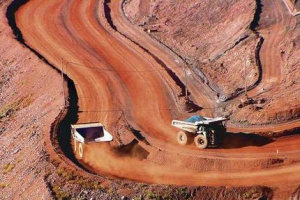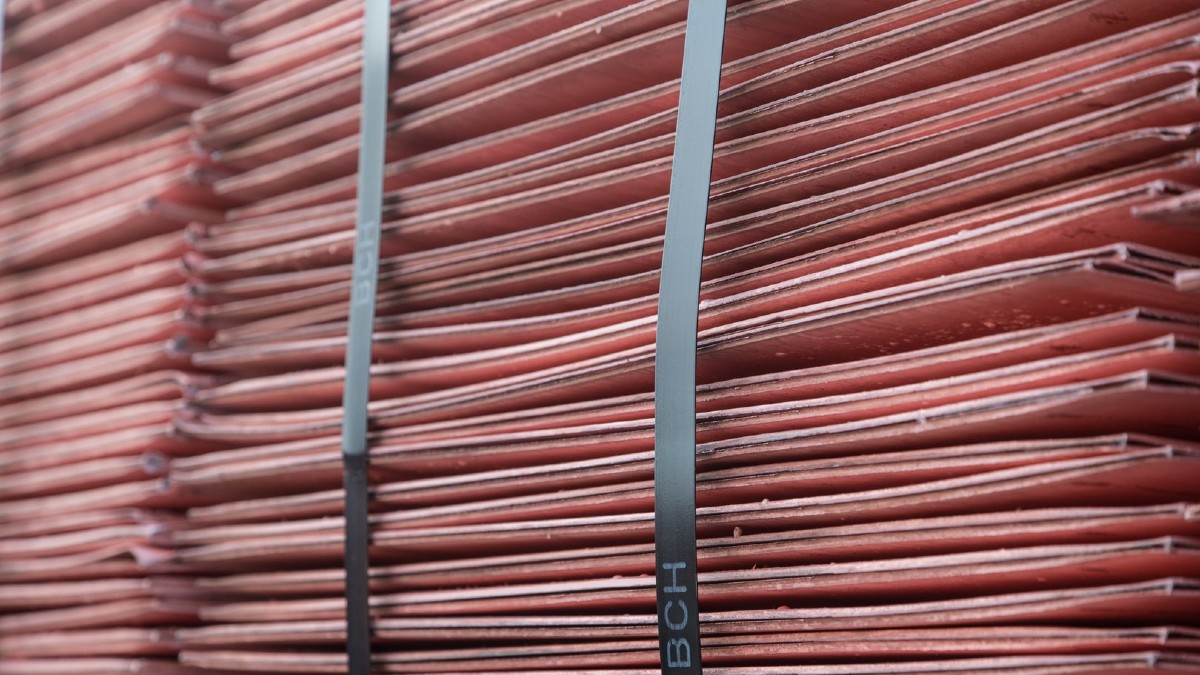Nyheter
David Hargreaves on Iron ore, week 14 2012
 Iron Ore continues to dominate news in the bulk trade, as befits a mineral whose output is measured at over one billion tonnes per year and growing at over 6% annually. That alone is the combined exports of Canada and South Africa.
Iron Ore continues to dominate news in the bulk trade, as befits a mineral whose output is measured at over one billion tonnes per year and growing at over 6% annually. That alone is the combined exports of Canada and South Africa.
Of greatest importance is that as an export-driven trade, critical to producers such as Australia, Brazil, India and the CIS. Further, almost 60% of all is destined for China and 20% for Japan and South Korea. The market is effectively polarised.
Contract pricing ruled for many years in annual bargains driven by the above importers and the major producing companies Vale SA (24% world production), Rio Tinto (14%) and BHPB (10%). Now it has all but broken down and been replaced by reference to the spot market. The growth of that mechanism owes much to the development of diversified production bases in West Africa and continued growth in the established mining locations. Much has been made of the possible economic slowdown in China. In context, this means that last year’s 9.3% increase may only be 8% this year. That is still another 80Mtpy. There are warnings of the spot price softening but this has not been borne out. It further nudged up to $145.2/t thisweek even as new investment and output news flows in. Increasingly, users are investing in mines to secure supplies.
- Japanese trader Marubeni is teaming up with South Korea’s steel maker Posco and ship builder STX to buy 30% of the Roy Hill project in Australia, whose plan is to hit 55Mtpy by 2014. That works out at about $220/t of output or 1.50 x the sales price.
- AIM listed but with loftier ambitions, London Mining (285p; Hi-Lo 438p-256p) is now fully funded to boost capacity at its Marampa, Sierra Leone mine to 5Mtpy. It has an offtake agreement with trading company Vitol. It also has an offtake contract with Glencore. Both have prepayment clauses. There is a further target of 9Mtpy.
Iron ore pricing. Wood MacKenzie sees iron ore supply and demand coming into balance over the next few years and the price slowly to decline. Their range is $157/t in 2012, $155/t in 2013 and $140/t in 2014. They warn of projects in the riskier and less developed regions suffering. Demand growth in China is pitched at 5% per year. They look for coking coal, essential to steel making, to average $200-215/t in the next few years.
Chrome Ore. A much misunderstood metal, its major end use is as ferro-chrome for use in steel making, particularly the stainless variety. This is achieved by mixing the ore with iron and coke, a relatively expensive process but with a resultant price enhancement. Resources are not a problem, measuring over 300 years at present rates of usage. However they lie selectively in RSA (70%) Russia and CIS (10%) and Zimbabwe (10%). South Africa has long been the dominant producer, but its share of supply as ferro-chrome (as opposed to chrome ore) has slipped from 50% in 2001 to 42% now, with China’s share up in the same period from 5% to 25%. Much of China’s output arises from raw ore shipped from RSA. This has been noticed in high places. They tell us the industry employs 200,000 people and its exports are worth R42bn to GDP. So there is a call to slap a duty of $100/t on raw chrome exports, to encourage local beneficiation. Problem: it is energy intensive and to show the comic-tragic nature of the situation, even as the call went out for the export tax, at least one ferrochrome producer was cutting back on its electricity usage at the behest of power generator Eskom. You can’t have your pasties and eat them, chaps
[hr]
About David Hargreaves
David Hargreaves is a mining engineer with over forty years of senior experience in the industry. After qualifying in coal mining he worked in the iron ore mines of Quebec and Northwest Ontario before diversifying into other bulk minerals including bauxite. He was Head of Research for stockbrokers James Capel in London from 1974 to 1977 and voted Mining Analyst of the year on three successive occasions.
Since forming his own metals broking and research company in 1977, he has successfully promoted and been a director of several public companies. He currently writes “The Week in Mining”, an incisive review of world mining events, for stockbrokers WH Ireland. David’s research pays particular attention to steel via the iron ore and coal supply industries. He is a Chartered Mining Engineer, Fellow of the Geological Society and the Institute of Mining, Minerals and Materials, and a Member of the Royal Institution. His textbook, “The World Index of Resources and Population” accurately predicted the exponential rise in demand for steel industry products.
Nyheter
Gruvbolaget Boliden överträffade analytikernas förväntningar

Gruvbolaget Boliden överträffade analytikernas förväntningar med bred marginal när man presenterade resultatet för det tredje kvartalet. Mikael Staffas, vd för Boliden, kommenterar kvartalet och hur han ser på råvarumarknaden och bolagets olika gruvprojekt.
Nyheter
Australien och USA investerar 8,5 miljarder USD för försörjningskedja av kritiska mineraler

USA:s president Donald Trump och Australiens premiärminister Anthony Albanese undertecknade på måndagen ett avtal som ska tillföra miljarder dollar till projekt inom kritiska mineraler.
Länderna kommer tillsammans att bidra med 1-3 miljarder dollar till projekten under de kommande sex månaderna. Den totala projektportföljen är värd 8,5 miljarder dollar, enligt regeringarna.
Galliumraffinaderi med kapacitet för 5x USA:s efterfrågan
Som en del av avtalet kommer det amerikanska försvarsdepartementet även att investera i ett galliumraffinaderi i västra Australien med en kapacitet på 100 ton per år. För närvarande importerar USA omkring 21 ton gallium, vilket motsvarar hela den inhemska konsumtionen, enligt den amerikanska geologiska myndigheten.
Initiativet kommer samtidigt som Kina har infört exportrestriktioner på vissa mineraler, däribland sällsynta jordartsmetaller, som är avgörande för tillverkningen av elektronik och elmotorer. Gallium används till exempel i mikrovågskretsar samt blå och violetta lysdioder (LED), vilka kan användas för att skapa kraftfulla lasrar.
Nyheter
Vad guldets uppgång egentligen betyder för världen

Guldpriset har nyligen nått rekordnivåer, över 4 000 dollar per uns. Denna uppgång är inte bara ett resultat av spekulation, utan speglar djupare förändringar i den globala ekonomin. Bloomberg analyserar hur detta hänger samman med minskad tillit till dollarn, geopolitisk oro och förändrade investeringsmönster.
Guldets roll som säker tillgång har stärkts i takt med att förtroendet för den amerikanska centralbanken minskat. Osäkerhet kring Federal Reserves oberoende, inflationens utveckling och USA:s ekonomiska stabilitet har fått investerare att söka alternativ till fiatvalutor. Donald Trumps handelskrig har också bidragit till att underminera dollarns status som global reservvaluta.
Samtidigt ökar den geopolitiska spänningen, särskilt mellan USA och Kina. Kapitalflykt från Kina, driven av oro för övertryckta valutor och instabilitet i det finansiella systemet, har lett till ökad efterfrågan på guld. Även kryptovalutor som bitcoin stiger i värde, vilket tyder på ett bredare skifte mot hårda tillgångar.
Bloomberg lyfter fram att derivatmarknaden för guld visar tecken på spekulativ överhettning. Positioneringsdata och avvikelser i terminskurvor tyder på att investerare roterar bort från aktier och obligationer till guld. ETF-flöden och CFTC-statistik bekräftar denna trend.
En annan aspekt är att de superrika nu köper upp alla tillgångsslag – aktier, fastigheter, statsobligationer och guld – vilket bryter mot traditionella investeringslogiker där vissa tillgångar fungerar som motvikt till andra. Detta tyder på att marknaden är ur balans och att kapitalfördelningen är skev.
Sammanfattningsvis är guldets prisrally ett tecken på en värld i ekonomisk omkalibrering. Det signalerar misstro mot fiatvalutor, oro för geopolitisk instabilitet och ett skifte i hur investerare ser på risk och trygghet.
-

 Nyheter4 veckor sedan
Nyheter4 veckor sedanOPEC+ missar produktionsmål, stöder oljepriserna
-

 Nyheter2 veckor sedan
Nyheter2 veckor sedanGoldman Sachs höjer prognosen för guld, tror priset når 4900 USD
-

 Nyheter3 veckor sedan
Nyheter3 veckor sedanBlykalla och amerikanska Oklo inleder ett samarbete
-

 Nyheter3 veckor sedan
Nyheter3 veckor sedanGuld nära 4000 USD och silver 50 USD, därför kan de fortsätta stiga
-

 Analys4 veckor sedan
Analys4 veckor sedanAre Ukraine’s attacks on Russian energy infrastructure working?
-

 Nyheter2 veckor sedan
Nyheter2 veckor sedanLeading Edge Materials är på rätt plats i rätt tid
-

 Nyheter3 veckor sedan
Nyheter3 veckor sedanEtt samtal om guld, olja, koppar och stål
-

 Nyheter2 veckor sedan
Nyheter2 veckor sedanNytt prisrekord, guld stiger över 4000 USD













